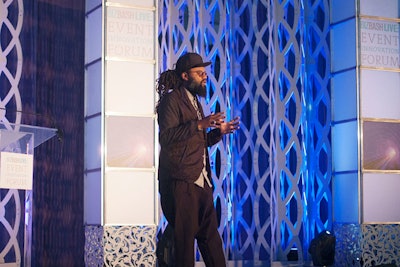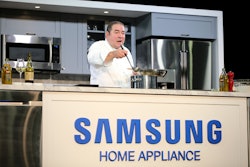
Event pros who have worked with brands such as Google, Target, Bud Light, and Cadillac shared insights with attendees at the Event Innovation Forum, which was part of BizBash Live: The Expo New York, held Tuesday at the Jacob K. Javits Convention Center. From maintaining sponsor relationships to cultivating a new generation of philanthropists, here are some of their key points.
1. Influencers are more important than celebrities.
Coltrane Curtis, founder and creative director of Team Epiphany, has a message that often shocks brands: “We believe that influence marketing and influencers are more powerful than celebrities are or celebrities ever will be,” he said. “We can prove it, and it’s no longer a hypothesis.” The old model of booking a celebrity for an appearance does generate press, but typically that coverage overshadows the brand. So what does the brand really gain? Curtis said finding the right influencers—passionate people who are recognized as experts in a certain community and passionate about the subject—can create energy and authentic buzz for a brand. “That’s where you start getting your engagement with consumers,” he said. “You’re identifying somebody who’s having a conversation with a community we want to be involved with as a brand.” Team Epiphany has used influencer marketing in successful campaigns with brands such as Heineken and Cadillac. “We believe it’s the most powerful marketing tool you can have in your toolbox,” he said.
2. Event inspiration can come from anywhere.
After radio consultant Keith Hill made a sexist comment in June comparing female country musicians to tomatoes in a salad (it became known as #SaladGate on Twitter), Internet streaming radio service Pandora decided to develop an event to show support for female country artists. The result was Women in Country, a benefit concert that took place in New York earlier this month, which featured singers Martina McBride, Cassadee Pope, and RaeLynn. For Nicole Carbone-Rogers, senior of director of events at Pandora, it was important to define the event's objective, be strategic about when and where to hold the event, and to not lose sight of the theme. "We brought the event to New York to keep that consumer base, and looked at October because it's a female-based month with breast cancer awareness," Carbone-Rogers said.
3. Have a game plan for sponsors.
Cultivating event sponsors is a job that happens before, during, and after an event. Michelle Grech, president of the sports and entertainment marketing firm Melt, described her firm’s handling of client clothing retailer Gildan’s sponsorship of country star Blake Shelton’s tour. At a special concert, Melt installed a Gildan exec to introduce Shelton and also had staff at the event dedicated to taking care of Gildan’s needs. “You need to understand what people feel comfortable with and what their role will be,” Grech said. After the event, Grech advised to immediately follow up with sponsors with ideas for new concepts “while still in the glow of the event.” Start with a nicely packaged recap of the event with video, photos, and feedback from guests surveys, and send thoughtful thank-you gifts. After the Blake Shelton concert, executives received guitars with the Gildan logo that Shelton had signed. These touches can lead to more business. “Plant the seed that this is a multi-event deal,” she said.
4. Turn your audience into your brand advocates.
With smartphones, everyone now has a voice and becomes a content creator. The challenge for brands is creating experiences that will give people something to talk about. “Events are becoming the core DNA of brands,” said Khaleed Juma, creative director of Mosaic. “How do we begin to create experiences that drive people to want to talk and share and then become the voice of your brand?” Mosaic produced one of the most memorable—and extensive—recent activations for Bud Light by taking over an entire town and turning it into the fictional “Whatever, USA” for three days of concerts, sports activities, and other activations. “This was a very different approach that turned every single person into an empowered storyteller,” Juma said. “Everyone had an experience that they wanted to talk about that was so different and so unique.”
5. Think about how you can attract young donors.
The Robin Hood Foundation’s gala raises the most money of any in New York City. And its leaders are already working to attract the next generation donors, said Sunny Longbons, the organization’s director of development. They knew events would be a critical component of their strategy. "Once we defined our primary goal as cultivation and stewardship, it helped us refocus the program to attract next generation donors," she said. She cited personal invites, gender balance at events, and different experiences as key ways that Robin Hood reaches younger donors, which they dub P.Y.T.s (or Philanthropic Young Things) in a play off the Michael Jackson song.
"We say that the P.Y.T. group helped us get our mojo back. The group includes more people from tech, media, and other diverse industries, and it generates a lot of buzz and keeps us relevant," said Longbons. "We have P.Y.T. members who also host events on their own with very little Robin Hood involvement, and we directly receive those funds. This program isn't just about fund-raising—it's also about giving them that hands-on experience and teaching them about philanthropy."
6. Every event should have a social benefit.
Community-minded millennials expect brands to advocate for causes and stand for something, Juma said. “Brands that are embracing the idea of social good or finding a sense of purpose are actually empowering people to co-author their stories with them. Now it’s not just about a selfish story, it’s a selfless story.” Events—even for beer brands—need to reflect those values. At "Whatever, USA," Juma said Bud Light sought to give back by working with a local food bank and making a donation to the town, among other projects.
Pandora’s Women in Country event had a charitable partner, the T.J. Martell Foundation. Whenever someone shared a photo from the social photo booth with the hashtag #WomenInCountry, Pandora donated $5 to the foundation. During Pandora’s post-event review, Carbone-Rogers said the team decided that they could have done more to promote the charitable tie-in before the event. Since the overall concept was successful and likely will be replicated, Pandora will incorporate that lesson in future events, she said.
7. Use social media in a more natural, fun way.
More brands are figuring out the "Internet of things" with campaigns that involve everyday physical products that have network connectivity. Instead of forcing social media into an event, smart campaigns will build it into an everyday situation, according to DJ Saul, C.M.O. and managing director of digital agency iStrategy Labs. Budweiser Canada's in-home “red goal light” syncs to the performance of the user’s favorite hockey team. Budweiser's Buddy Cup automatically sends Facebook friend requests to anyone whom you cheers with at a Budweiser event. And SkyTV's #BringDownTheKing campaign for Season 5 premiere of Game of Thrones featured a statue of the show's most hated character, Joffrey, which was slowly toppled every time a tweet was posted with the hashtag. Saul said providing gesture technology, wearables, and more at events will "give guests superpowers."
8. The little details matter.
How well do you train event staff? If you invest time in the people on the front lines, it will pay off with a better experience for guests, according to Ben Nazario, senior vice president of global event marketing agency Sparks. It was just one of the small details that he said contributes to a successful event. Small is the new big, he said. Even at trade shows that cover one million square feet, intimate spaces can be carved out to give people the choice of how they want to experience the event. Do you want to watch a keynote in a massive theater or in a small room with a live feed? Another detail that planners might overlook is the "micro side" of messaging. "You have to make sure everything is spelled right, all of the type faces are the same, and the font size is proper for where people are walking," said Nazario. "This can make or break what you see posted on Twitter about your event."
9. You can now quantify the energy of your event.
When should a DJ play an upbeat or lower-key song? How do you motivate a crowd to get excited? Attendees can instantly give feedback without saying a word through wearable technology, which is now starting to be deployed at events. “The way that we currently measure this is through feeling, through intuition,” said Rana June, founder and C.E.O. of bioanalytics platform Lightwave. “We say great events have a great energy. But what does that mean? What does one experience have but the other doesn’t?” Lightwave collects biometric data from event attendees and then translates that into personalized activations, directives to event planners, or other actions. That could mean changing the lighting in a venue to reflect the engagement level of the audience or shaping the soundtrack based on the emotion at your event.
Lightwave’s technology has been used at a biometric concert for Pepsi at South by Southwest, an interactive quiz for Target at the TED Conference, and an animated billboard for Jaguar at Wimbledon. Planners are “able to in real time change the course of what you’re doing or move things around or make a decision based on the data,” she said. “You have such a unique opportunity to connect with audiences.”



















